 The Avro Arrow:
The Avro Arrow:

 The Avro Arrow:
The Avro Arrow:

Canada's Broken Dream++*
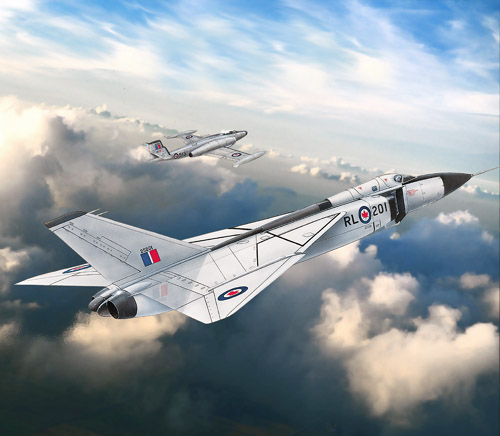
Nov. 1, 1951 - Jan. 13, 1997
It's the closest thing Canadian industry has to a love story and a murder
mystery. The Avro Arrow, a sleek white jet interceptor developed in Malton,
Ontario in the 1950s, could have been many things. It might have become the
fastest plane in the world, our best defence against Soviet bombers, the
catalyst to propel Canada to the forefront of the aviation industry. Instead, it
became a $400-million pile of scrap metal, and the stuff of legends.
The RCAF needs a new plane
To catch Soviet bombers, the Royal Canadian Air Force puts out the call for a
jet that will fly faster, higher and further than anything on the market.
The Story
At the end of the Second World War, Canada is one of the world's major
industrial powers. The Royal Canadian Air Force is the third largest in the
world, and aircraft manufacturer A.V. Roe Canada produced some of the best
bombers of the war. In 1949 the company introduces the North America's
commercial jet, the Avro Jetliner, but then the Korean War breaks out and all
efforts turn towards producing jet warplanes.
Avro's latest success story is the CF-100 "Canuck," a long-range, all-weather
jet designed to intercept nuclear-armed Soviet bombers crossing the Arctic
Ocean. But there are fears of a "bomber gap," and the RCAF wants a plane that
can fly higher and faster than anything currently available. Avro, under new
president and general manager Crawford Gordon, has the answer.
Did You Know?
- The Royal Canadian Air Force wanted a plane that could defend the Canadian
Arctic from new Soviet bombers. They studied all jets that were currently
available, including the McDonnell F-101 Voodoo, but rejected them. In April
1953, the RCAF announced specification "Air-7-3," calling for a new supersonic
twin-engine, two-seat interceptor. The plane was to have a range of 1100
kilometres and a top speed over Mach 1.5. A contract was awarded to Avro in
December 1953.
- The Canadian government-owned Victory Aircraft company in Malton was bought by
Britain's Hawker Siddeley, and renamed A.V. Roe Canada, which became Avro Canada
Ltd.
- Crawford Gordon became president and general manager of A.V. Roe Canada in
1951, at age 37. He was a protégé of Liberal minister C.D. Howe, who was
responsible for Canadian industrial production during the Second World War.
Gordon immediately diversified the company, turning it into 39 separate
companies, including Avro Canada and Orenda Engines.
- The Avro Jetliner was built for Trans Canada Airlines (which became Air
Canada.) Only one Jetliner was ever built. It carried airmail from Toronto to
New York in April 1950 and set numerous records before C.D. Howe ordered Avro to
suspend production and focus on warplanes.
- The sole Jetliner was leased to American aircraft mogul Howard Hughes for six
months, who used it as a personal toy. In February 1957 it was cut up for scrap.
- Avro began designing the CF-100 "Canuck" in 1946; the first one flew in
January 1950. It is the only operational Canadian combat aircraft ever built.
The plane was not ready for use in the Korean war, but 692 were built between
1950 and 1958. Belgium used 53 CF-100s.
- The Canuck took its name from the Curtis JN-4 Canuck trainer used in the First
World War. Unofficially, pilots and crew members referred to it as the "Clunk."
- An "interceptor" is any fighter or missile designed to stop enemy aircraft or
missiles.
Unveiling the Arrow

The first sleek white Avro Arrow is unveiled in front of a crowd of 12,000 at
the Avro Plant in Malton. But the Russians unveil something of their own.
The Story
After four years of work by 14,000 people, the first Avro Arrow is wheeled out
of a hangar in Malton, Ont. on Oct. 4, 1957. A huge crowd is on hand to marvel
at the sleek white craft. But the Arrow's timing turns out to be disastrous: the
Soviet Union launches the Sputnik 1 satellite the same day, diverting attention
from the Arrow and prompting some Canadians to begin rethinking the country's
approach to strategic defence.
Did You Know?
- Sputnik 1 was the world's first artificial satellite. It was the size of a
basketball and weighed 83 kilograms. While it didn't really "do" anything other
than beep, it caught the West off guard. Many feared the Soviets could use the
same rocket technology to launch ballistic missiles carrying nuclear weapons
from Europe to North America. Sputnik began the space race and led directly to
the creation of the U.S. National Aeronautics and Space Administration (NASA).
- At the unveiling of the Arrow, Defence Minister George Pearkes said that
although we are entering the missile age, the era of manned aircraft was not
over. He said that aircraft and missiles complement each other, and aircraft
have the advantage of introducing human judgement into battle. Unlike missiles,
aircraft can turn back. Later, Pearkes was instrumental in the cancellation of
the Arrow program.
The Arrow's maiden flight
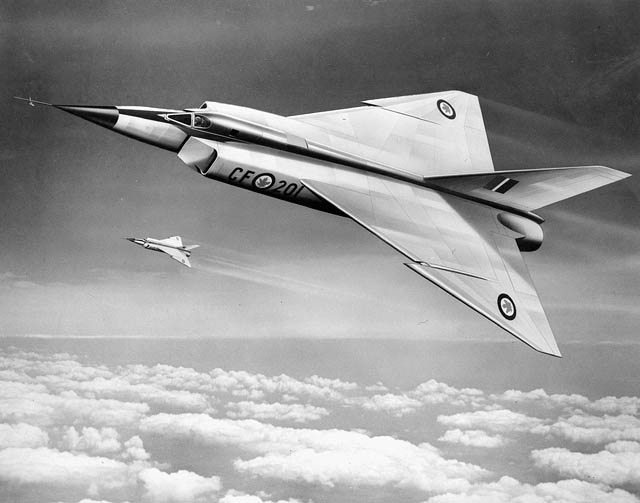
Canada's first supersonic fighter plane makes its triumphant first flight.
The Story
At 9:52 a.m. on March 25, 1958, Arrow RL-201 roars into the skies above Malton
for the Avro Arrow's first test flight. Three kilometres below, all
non-essential Avro staff pour out of the plant to watch their plane circle
overhead. Some 35 minutes later, the Arrow touches down and comes to a halt,
braking parachutes trailing behind. Test pilot Janusz Zurakowski, who is given a
hero's welcome, complains only that the cockpit has no clock.
Did You Know?
- Arrow RL-201 used just half of the runway before taking off at a steep 45
degree angle. It flew up to 3,350 metres high at speeds up to 250 knots - a
small fraction of its capability. The only problem recorded was the failure of
two tiny switches (out of 4,000) in the plane's nose gear bay.
- Two chase planes followed the Arrow's maiden flight. Jack Woodman flew a F-86
Sabre and Wladek "Spud" Potocki flew a CF-100 with a photographer aboard.
- Zurakowski and Potocki were both Polish pilots who flew for the Royal Air
Force during the Second World War before moving to Canada. The only other pilots
to fly the Arrow were Peter Cope and RCAF Lt. Jack Woodman.
- There were many Arrow tests on the ground before the maiden flight. During one
taxi test ,all four tires on the main wheels exploded. The landing gear failed
during two test flights, causing minor accidents.
- On subsequent test flights, the Arrow flew 15,240 metres high and reached
speeds of Mach 1.98 (over 2,000 kilometres per hour, nearly twice the speed of
sound.) In 1958 there were 57 Arrow test flights totalling 61 hours.
- All five of the first Arrows used Pratt & Whitney J75 engines. Orenda Engines,
a division of Avro, began developing a much more powerful engine, the PS-13
Iroquois, in 1953. These engines would be installed in the "Arrow Mark 2,"
beginning with RL-206. These engines used expensive titanium to keep weight
down. Avro expected the Arrow to break all world speed records once the Iroquois
was installed.
Is the era of manned aircraft over?
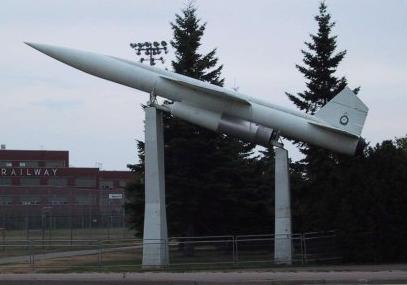
The Bomarc missile casts a shadow over the Avro Arrow as Canada enters the
missile age.
The Story
The Arrow is poised to become the fastest aircraft on the planet, but some
critics are asking if it matters anymore. As the Soviets and Americans race into
the age of missile defence, the U.S.-built Bomarc missile is now front and
centre in North American defence strategy. The Arrow, built to chase bombers,
may be on shaky ground.
Did You Know?
- In 1957 Prime Minister John Diefenbaker agreed to join the United States in an
integrated North American Air Defence (NORAD) treaty. It was a controversial
decision because he did not consult his cabinet first, and the decision raised
questions about Canada's sovereignty. And it raised concerns about Canada's
commitment to the Arrow.
- NORAD was focussed on implementing two new weapons systems, the Bomarc missile
and the Semi-Automated Ground Environment (SAGE) surveillance and weapons
control system. The Bomarc was a surface-to-air guided missile with a range of
640 kilometres. In September 1958, Diefenbaker announced that two squadrons of
Bomarc-B anti-aircraft missiles would be stationed at North Bay, Ont. and La
Macaza, Que.
- The Bomarc was an anti-aircraft weapon, as was the Arrow. It would not defend
against nuclear Intercontinental Ballistic Missiles (ICBMs). The Americans were
planning to use the Bomarc to destroy bombers that their manned interceptors
missed. The Bomarc carried a nuclear warhead and would destroy an enemy plane by
detonating a nuclear explosion nearby. Canada was under some pressure to build
northern Bomarc stations to avoid these explosions happening over heavily
populated Southern Canada.
Crawford Gordon reacts to blow to Arrow program
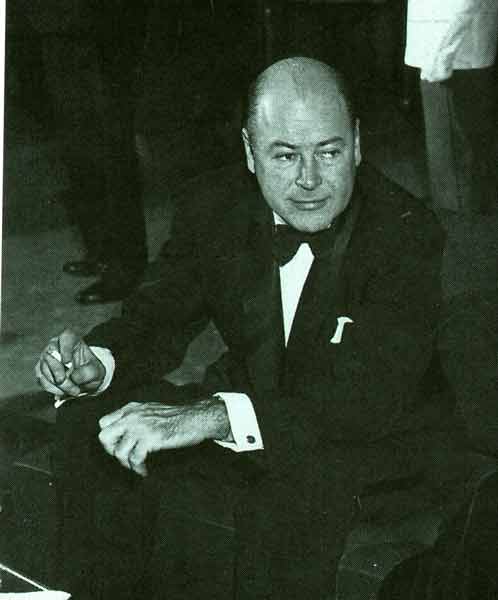
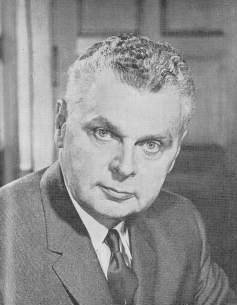
Crawford Gordon and John Diefenbaker
Prime Minister John Diefenbaker has some bad news for Avro, but Avro president
Crawford Gordon puts on a brave face.
The Story
Less than a week after the Arrow's first flight, Conservative John Diefenbaker
becomes prime minister in a landslide electoral victory, and inherits the Arrow
program from Liberal Prime Minister Louis St. Laurent. Diefenbaker distrusts
Avro executives and is gravely concerned about the spiralling costs of the Arrow
program. In September 1958 he announces that the government will not complete
the full run of Arrow production, but will only authorize completion of planes
currently in production.
Diefenbaker then announces that the entire Arrow program will be reviewed in six
months. Avro president Crawford Gordon goes on the defensive, taking to the
airwaves to reassure the public and Arrow workers that this does not mean
the Arrow program is cancelled.
Did You Know?
- Following Diefenbaker's announcement, Avro began a determined campaign to get
the decision reversed, lobbying the public, the federal government, and even the
United States Air Force to shore up support for the Arrow.
- Ontario's Crawford Gordon was a Liberal protege and had a reputation for
volatility. Many believe he shared a mutual animosity with Prime Minister
Diefenbaker, a Saskatchewan lawyer who distrusted the Bay Street whiz-kid.
- The Arrow program was becoming increasingly expensive, and consumed a large
portion of Canada's defence budget. Avro continually approached the government
for more money; by 1958 the government estimated that it would cost over $1
billion to complete production of the Arrow. There were clearly doubts Canada
could fund both the Arrow and the Bomarc missile at once.
Diefenbaker announces cancellation of the Arrow
Shocking Parliament and Avro employees, Diefenbaker announces the Arrow and
Iroquois engine programs are cancelled immediately.
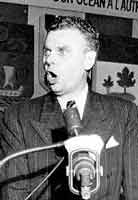
The Story
It's a day that would soon become known as "Black Friday." At 11:00 a.m. on Feb.
20, 1959, Prime Minister Diefenbaker stands before the House of Commons and
makes the unexpected announcement that the Arrow and Iroquois engine programs
are terminated immediately. Members of Parliament greet the announcement with
stunned silence. CBC Radio reporters Norman DePoe and Tom Earle are on hand to
witness the announcement and get a first-hand explanation from Prime Minister
Diefenbaker.
Did You Know?
- A key reason for cancelling the Arrow was the mounting cost of the program.
Though the Arrow was an expensive plane, critics of the cancellation later
argued that development could have been completed for the cost of the
cancellation fees alone. The Arrow program was cheaper than purchasing the
Bomarc, SAGE and replacement interceptors from the United States. It was
cancelled a month before the end of the six month review period Diefenbaker gave
the program.
- Canada still needed jet interceptors. Two years later the RCAF took possession
of 66 used McDonnell F-101 Voodoo jet fighters from the United States, a plane
they had rejected as inadequate before commissioning the Arrow. The planes were
eventually given to Canada in exchange for Canadians staffing radar bases on the
Arctic's Pinetree Line, the first of three Cold War lines of air defence that
included the Distant Early Warning (DEW) Line and the Mid-Canada Line.

- The Voodoos were eventually replaced by the MacDonnell-Douglas CF-18 Hornets
used today. Between 1982 and 1988 the Canadian government purchased 138 Hornets
from the United States at a cost of $5.2 billion.
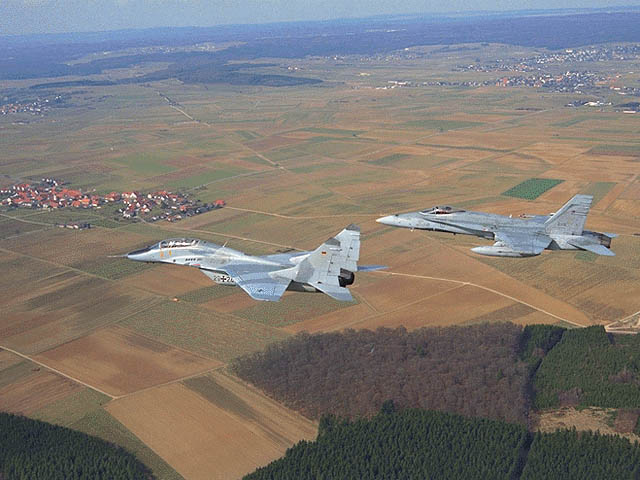
- Defence Production Sharing was supposed to allow Canadian firms to compete on
an equal footing with their American counterparts. But Canadian bids on defence
contracts suffered from built-in delays and price penalties that usually
favoured U.S. competitors.
- Other nations were also under the impression that manned fighters would become
obsolete in the age of missiles. In April 1957, British minister of defence
Duncan Sandys published a white paper arguing that all British fighter projects
should be cancelled in favour of ground-launched missiles. The paper spelled the
end of many British aircraft manufacturers. The United States Air Force
cancelled similar interceptor plans.
- Canada and the United States were hotly debating deployment of atomic weapons
in Canada. U.S. President John F. Kennedy demanded Canada accept the atomic
warheads that the Bomarc was designed to carry. Diefenbaker said he was against
it, which prompted the resignation of his Minister of National Defence Douglas
Harkness. That forced a no-confidence vote in the House of Commons, leading to
the collapse of Diefenbaker's minority government and the subsequent Liberal
minority of Lester B. Pearson.
- The nuclear warheads were eventually delivered on Dec. 31, 1963 and remained
in the Canadian armoury until 1969.
- The Bomarc and SAGE were ineffective systems, and were soon phased out in both
Canada and the United States. Both of Canada's Bomarc squadrons formally
disbanded on April 7, 1972, and the missiles were returned to the United States.
Political reaction to the Arrow's cancellation
Despite the huge impact the Avro Arrow's cancellation will have on Canadian
industry and defence, opposition leaders won't criticize the decision.
The Story
The decision to cancel the Avro Arrow means $400 million wasted tax dollars,
instant unemployment for thousands of workers, and a defence department turned
upside down. Yet the leaders of the two main opposition parties do not oppose
the decision. Liberal leader Lester B. Person and Hazen Argue of the
Co-operative Commonwealth Federation (CCF) choose their words carefully.
Did You Know?
- Lester B. Pearson joined the government in 1928 in External Affairs, and was
elected to the House of Commons in 1948. He was active in the United Nations and
became president of the Seventh UN General Assembly. He was awarded the Nobel
Peace Prize for his proposal to send a peacekeeping force to the Suez Canal
area. He became leader of the federal Liberal party and was elected Prime
Minister in 1963.
- Hazen Argue was elected to the CCF in 1945 at age 24 and became party leader
in 1960. When the CCF became the New Democratic Party a year later, Argue ran
for leader, losing to Tommy Douglas. Argue joined the Liberals and was
eventually made a senator by Pearson. He became the first Canadian Senator to
face criminal charges (misusing Senate funds) in 1989, but died before the case
went to trial. He was Canada's longest serving parliamentarian.
- The cancellation of the Arrow was a tragedy for workers in the Toronto area,
and local media criticized the decision. But outside Ontario, there was little
reaction.
Avro workers react to massive layoffs
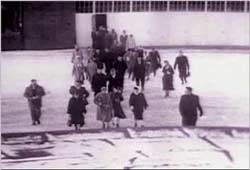
14,525 shocked Avro workers are terminated at once. As they leave, they express
their anger to CBC reporters.
The Story
Shock. Disbelief. Anger. Despair. These are the reactions of the 14,525 Avro
workers who found themselves unemployed en masse on Black Friday. CBC Radio's
Bill Beatty is at the plant to witness "a funeral procession" of hundreds of
cars, lined up bumper-to-bumper, carrying toolmakers, engineers and office
workers from the plant for the last time. Many of them offer Beatty their
parting shots.
Did You Know?
- Before noon on Feb. 20, 1959, the Department of Defence production told Avro
executives that the Arrow and Iroquois programs were cancelled and that all work
on the projects must cease that day. At 4:00 p.m. an announcement was made over
the plant loudspeaker that all employees were laid off immediately. Later on, a
small number of workers were called back to the plant to work on other projects,
and a compensation package was offered.
- At the time of the cancellation of the Arrow, Avro was the third-largest
corporation in Canada. The Arrow program employed more than 40,000 people at
Avro and related suppliers. The Malton and Brampton suburbs of Toronto were
hardest hit. About a quarter of Brampton's workers were employed at Avro.
- On Black Friday, chief engineer Robert Lindley asked Avro executives if he
could fly the Iroquois-equipped RL-206 just one time, but his request was
rejected.
- News of the cancellation came just two weeks before Arrow RL-206 was scheduled
to fly with the new Iroquois engine. Avro engineers had expected that plane to
smash the world speed record.
- The end of the Arrow and Iroquois meant the end of Avro Canada Ltd. Avro
president Crawford Gordon and executive vice-president Fred Smye believed the
message from the government was that the projects were cancelled and no more
projects would be offered.
The Arrow is destroyed
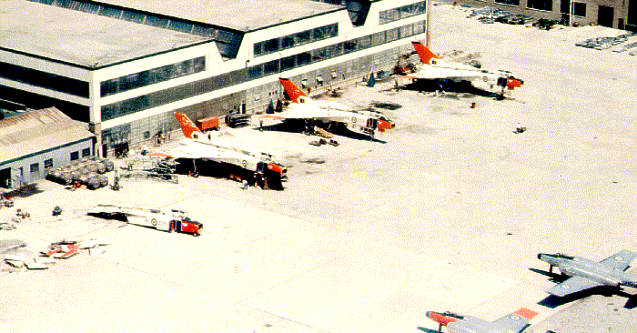
In an astonishing act of devastation, all traces of the Avro Arrow are ordered
destroyed.
The Story
To the horror of Avro employees, an order comes from the Ministry of Defence
Production to erase all traces of the Avro Arrow. Complete planes and those in
production are chopped into pieces, as are all models, tools and the entire
production line. Blueprints, pictures and film are destroyed. The remains of the
mighty plane are sold to a Hamilton scrap metal dealer and melted down to make
pots and pans.
Did You Know?
- Exactly who ordered the destruction of the Arrow remains a mystery - nobody in
the government or military admitted to giving the order. Avro's Fred Smye said
he got the call from the Department of Defence Production, and issued the order
to have the planes destroyed. He called it "the worst mistake I ever made in my
life." Pierre Sevigny, associate deputy minister for Diefenbaker, believed a
spiteful Crawford Gordon issued the order himself.
- Lax Brothers Salvage in Hamilton carried out the destruction and bought the
scrap from the entire Arrow program for $300,000. The production line was cut up
with acetylene torches, while the planes were chopped up with saws. Everything
went to the smelter. Metal from the cut-up Arrows was sold for about 14 cents a
kilogram - an entire 30,000 kilogram Avro Arrow went for a little over $4,000.
- Cameras were not allowed inside the Avro plant when the planes were destroyed,
but the Montreal Standard's Weekend Magazine chartered a helicopter and had a
photographer take pictures as the planes were dismantled.
- Test pilot Peter Cope compares the destruction of the Arrow to "a
destalinization project." Mario Pesando, chief of project research at Avro, says
it was "like the Romans at Carthage."
- Some pieces of the Arrow project survived the destruction and can be found in
museums across Canada. Many small pieces were smuggled out by employees. In
1998, two Arrow Pratt & Whitney J-75 engines were found at Ottawa's National
Research Council. The National Aviation Museum in Ottawa has the nose and
cockpit and landing gear from RL-206, a pair of wings, and an Iroquois engine.
Ironically, the museum also houses Canada's only remaining Bomarc missile.
Brain drain to the United States
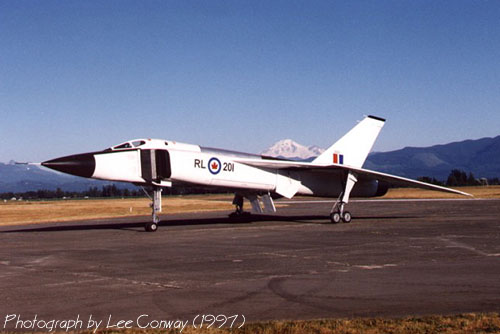
In the months following Black Friday, Avro's team of world-class engineers find
jobs south of the border.
The Story
Avro's greatest asset is the team of top-notch engineers it has assembled from
across Canada and around the world. But since Black Friday it looks like
Canada's aviation industry is on its last legs, and there is no longer a future
for these bright minds in this country. Efforts are made to keep them together,
but soon the exodus begins – particularly to an eager United States and its
burgeoning space program.
Did You Know?
- Avro vice president of engineering Jim Floyd worked to install teams of Avro
engineers in American companies like Lockheed and Boeing, hoping they could
eventually return to Avro. But Avro never reopened, and Floyd himself returned
to Britain to work on the Supersonic Transport studies that led to the Corcorde.
Other Avro engineers found work at General Electric and Pratt & Whitney in the
U.S.
- In the United States, the National Aeronautics and Space Administration (NASA)
had formed the Space Task Group to put astronauts in space. Thirty-three Avro
engineers and scientists were recruited, and went on to help develop the
Mercury, Gemini and Apollo programs.
- Avro chief of design Jim Chamberlain lead the Canadians at the Space Task
Group and was a key designer of the Mercury capsule that put John Glenn into
orbit on Feb. 20, 1962 - the third anniversary of Black Friday. Several ex-Avro
employees went on to work at NASA's Mission Control.
- Avro president Crawford Gordon, who once drew a salary greater than that of
the president of the United States, was fired after the cancellation. He worked
in Montreal for a while, squandering a $3-million fortune, and died impoverished
in New York City in January 1967. Friends say he drank himself to death.
Arrow mania
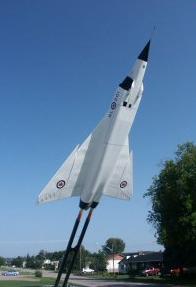
More than three decades after the Arrow's first flight, the doomed plane is
suddenly popular again.
The Story
More than 30 years after the Arrow met its demise, "Arrow heads" across Canada
are rebuilding the legend. Arrow books and movies are being written, replicas
are being built, and parts of the plane are turning up after years of
concealment. On CBC Radio's Morningside, Peter Gzowski finds out about the
plane's popularity by talking to Arrow fans including journalist June Callwood,
who believes that one Arrow may have escaped.
Did You Know?
- In 2002, volunteers at the Toronto Aerospace Museum were building a
full-scale, all metal replica of the Avro Arrow. It won't fly, but it is
designed to taxi along at six kilometres an hour.
- Another initiative, the "Arrow 2000 Project," hopes to build a flying
2/3-scale replica of the Avro Arrow.
- During the testing period of the Arrow's construction, nine 1/8-scale
magnesium alloy models of the plane were launched from Nike missiles into the
skies over Lake Ontario. In recent years, several groups have hunted for the
models on the lake bottom, and at least two have been found.
- There are many legends of a lone Arrow escaping destruction. In addition to
Callwood's speculation about an Iroquois-equipped arrow flying away at dawn,
there are tales of an Arrow being spirited away on a covered flatbed truck. Some
say that RL-202 cannot be seen in the aerial photos of the destruction, and may
have been being fitted with missiles at a different location. None of these
stories can be confirmed.
Debating the Arrow's legacy

Historian Michael Bliss and broadcaster and former Avro employee Elwy Yost go
head to head on what the Arrow meant to Canada.
The Story
In January 1997, CBC broadcasts a four-hour miniseries called The Arrow that
generates powerful reactions from Canadians who love or hate the legendary
plane. Calling in to CBC's Radio Noon, historian Michael Bliss calls the
miniseries "an orgy of mythologizing," arguing that Avro was a disaster and the
Arrow got what it deserved. Broadcaster Elwy Yost, who worked at Avro for six
years, says that's the most stupid statement he's heard in 40 years.
Did You Know?
- The Arrow was a two-part series starring Dan Aykroyd as Crawford Gordon. It
co-starred Sara Botsford, Michael Ironside, Michael Moriarity and Christopher
Plummer. It was shot in Winnipeg, Man. and featured a scale replica of the Arrow
built in Wetaskiwin, Alta. by sales estimator Allan Jackson. It was broadcast on
Jan. 12 and 13, 1997. The movie's "docudrama" format was generally well
received, but irritated some viewers who wanted greater historical accuracy.
- Michael Bliss is a University of Toronto history professor. He has published a
dozen books and is noted for his studies of Canadian medical history.
- Bliss tells his history students that the last Avro Arrow did indeed escape,
and is stored in a barn in Saskatchewan. "It is taken out and flown once a year.
By Elvis."
- Film historian Elwy Yost hosted TVOntario's Saturday Night at the Movies from
1970 to 1999. News programs aside, it is Canada's longest running television
series that is still on the air.
- Yost worked in the personnel department of Avro and was involved in laying off
thousands of workers. The last pink slip he issued was to himself.
Links
CBC News Online: Avro Arrow model found in Lake Ontario
Avroland: A site dedicated to the people and aircraft of AVRO Canada & Orenda
Engines Limited
Canadian Aviation Museum: Avro Arrow
FlightDeck Presents: Canada's Legendary Avro Arrow
Homage to the Avro Arrow
Arrow Alliance: The Arrow is Released
Avro Arrow Recovery Canada
The Legend of the Arrow
National Defence Historical Aircraft: Avro CF-105 Arrow Mk. 1
++Content ©2005 CBC
*Web Design ©2005 Brian Bogdan
Click below to return to 'OZ'